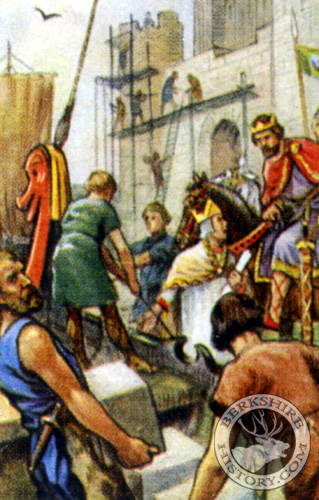|
|
|
 The Development of
Reading The Development of
Reading
Norman Times
Very soon after the Norman Conquest, the
nunnery in Reading seems to have been wound up. The abbess named in the Domesday Survey
(1086) may have been ruling there in name only if it had not been rebuilt after the
Viking destruction sixty years earlier. William the Conqueror gave the town, including
St. Mary’s Church, to his new foundation of Battle Abbey, built on the site of the Battle of Hastings. The Abbot’s estate was centred on his monastic grange at Battle Farm on the Oxford Road. The Royal estate still stood to the east.
At this time, Reading was not nearly as big as the administrative centre of the Ealdorman of Berkshire at
Wallingford, but it had grown into the only other definite town in the county. Twenty-nine town dwellings are
mentioned at Domesday, plus other outlying tenant farmers and cottage dwellers. The King had four (probably corn) mills and three fisheries, and the Abbot had two more of each. So the
River Kennet was providing a living for many residents.
In 1121, Reading’s development was given a huge boost when
King Henry I decided to establish a
Royal Abbey in the town. He had recently rebuilt the castle at
Windsor to replace the old Royal centre at
Old Windsor, and Reading was a convenient twenty miles away. The King specifically recorded that he chose to build his abbey in the town because of its good communications. He liberally endowed his foundation with lands, including the manor and borough of Reading. The building work took forty-three years to complete, briefly interrupted by the Civil War of King Stephen’s reign, when a motte-and-bailey castle was built in its grounds. During
this time, the town’s population must have exploded. When the labourers and craftsmen eventually dissipated, the abbey remained to establish a great injection of wealth and employment: administration, produce collection, maintenance and trade. Shortly after the foundation of the abbey, the monks built a small chapel, dedicated to
St. Laurence, adjoining its western Compter Gate. The idea was that it should serve the people of this
yet to be established part of the town,, east of St. Mary’s Church and the old market.
The monks deliberately laid out their own triangular market place, just south of St. Laurence’s,
with two wide shopping streets, lined with rentable properties, spreading westward from either end: New Street (now
Friar Street) and Shop Row (now
Broad Street).
The town was also quickly swelled by large numbers of pilgrims that the abbey attracted. The
abbey hospitium could only accommodate so many on site. In 1125, Henry I’s daughter, the Holy Roman
Empress Matilda, presented the Royal foundation with the Hand of St. James which her first husband's family had acquired in a roundabout way from the body at Santiago de Compostella. To this, King John added the skull of St. Philip in 1205, and there was an additional large collection of more minor relics. Unless you wanted to travel all the way to St. Andrew’s in Scotland, these were the major relics of the apostles easily
accessible to the English. Pilgrims even came from the Continent via London or Southampton. They moved westward through Reading, perhaps as far as Malmesbury Abbey and Gloucester Abbey; or moving northwards via Winchester Cathedral and Reading Abbey to Oxford Priory and beyond. The Shrine of Our Lady of
Caversham was also very popular. Henry I himself was buried at the abbey in 1136, and later Royals
followed. Although it is unlikely that their bodies attracted many
visitors, the funeral attendants would have expanded the town's
population for a short while..
To further promote the holy relics at the abbey, about 1130, Henry I granted the town the right to hold a
four day fair on St. James’ Day and a fair on St. Laurence’s Day was established about the same time. These would have brought traders and shoppers to Reading from far and wide. A four day May Day Fair in honour of both St. James & St. Philip was later granted, in 1205, by King John. These almost certainly took place in the Forbury. Despite the Abbot having control of all trading efforts in the town and successfully having shifted much activity from around St. Mary’s Butts to Broad & Friar Street, he was not allowed to transfer the main corn market to his new Market Place; and the townsmen defiantly established their first
Guildhall.
The abbey was often visited by important ecclesiastics, as well as the Royal family, and it became an important meeting place. In 1163, King Henry II
stayed at the abbey and sat in judgement over the famous
trial-by-combat between De Montfort and Essex on an island in the Thames; and, in 1185, he
entertained the Patriarch of Jerusalem there. Not only the king, but the lords and bishops who surrounded him would have had scores of servants and followers with them. The abbey was not big enough to accommodate everyone, and the numbers of inns and other hostelries, and all the other trades that supported them, in the town grew quickly. Between 1209 and 14, there was even a more permanent influx of residents when Oxford University was moved to Reading after a dispute over a number of deaths. Already by about 1190, there was a sizeable village on the south side of the River Kennet,
which needed their own church as floods often prevented them from journeying to St. Mary’s. So
St. Giles’ was built on the
lower slopes of Southern Hill.
Click for the Development
of Reading in Saxon Times
|
 |


 The Development of
Reading
The Development of
Reading




